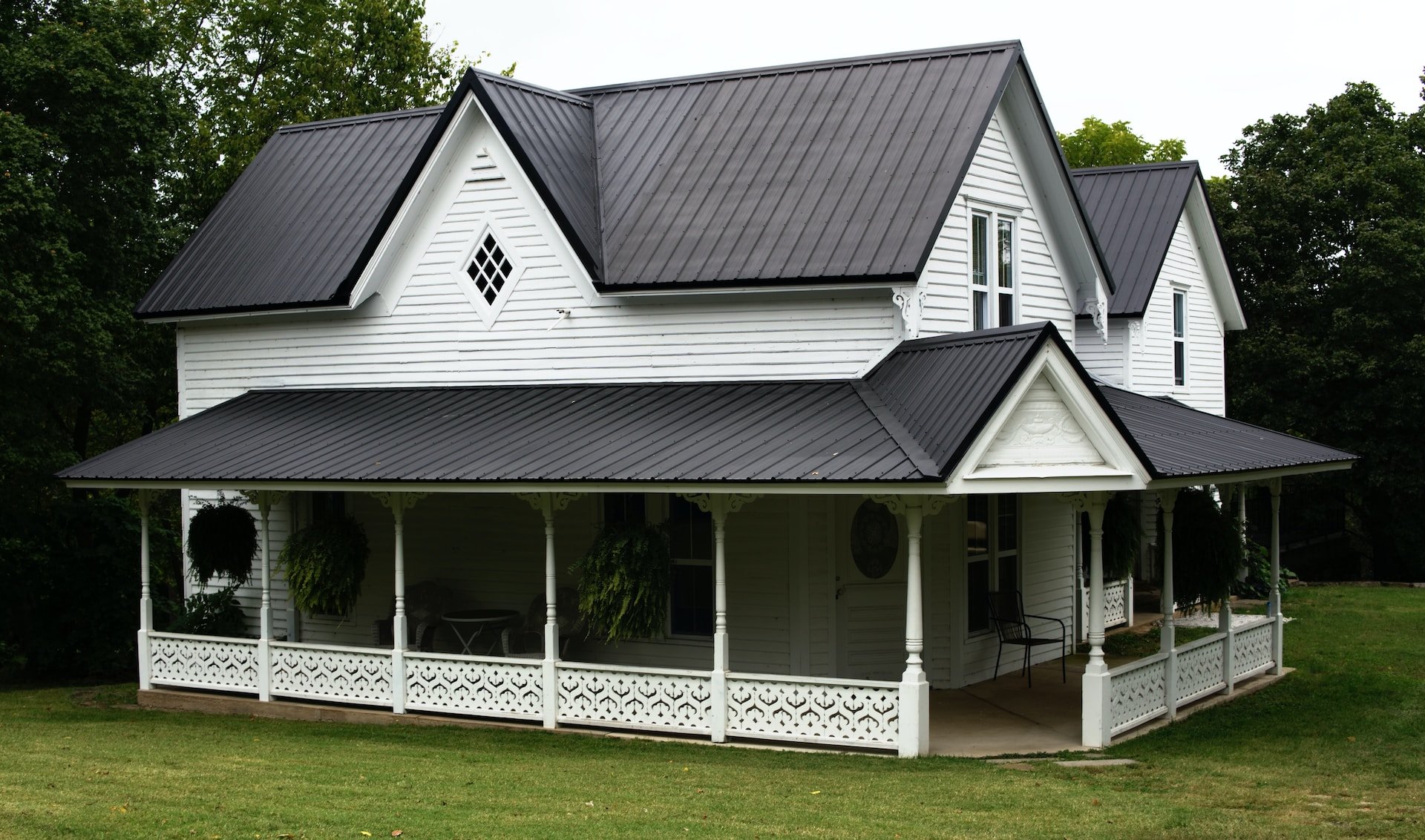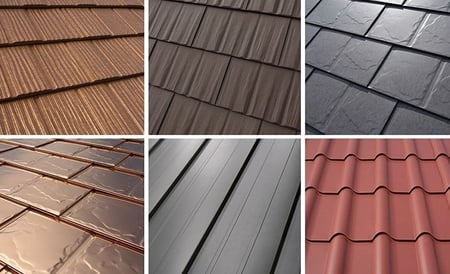
Embracing both functionality and aesthetic appeal, metal roofing stands as a resilient and versatile choice for homeowners seeking to up the ante on their home's functionality and curb appeal. Metal roofing comes in a variety of materials, each with its own distinct attributes and advantages. From the widely embraced strength of steel to the timeless elegance of copper, the choices are diverse.
Okay, we know what you’re thinking: there’s just so many! How do I choose? At RoofCrafters, we get it. Delving into metal roofing on your own can be a bit overwhelming, and much like walking into a supermarket and seeing the same can of chicken noodle soup, but labeled differently by 10 other companies. Which one’s better for you? Which one has the most nutrients? The list goes on.
So, if you’re interested in metal roofing for your home, but you're troubled by the numerous brands and options available to you, you’re in the right place. In this article, we’ll keep it basic. You’ll learn about the different types of metal roofing, which one’s the most common, and which metal roof is right for your home! Let’s get started.
What Are the Different Types of Metal Roofing?

Metal roofing comes in various materials, each with its own set of characteristics and advantages. Here are some of the most common types of metal roofing:
.png?width=1200&height=200&name=Recommended%20Reading%20(47).png)
Galvanized Steel: Steel coated with a layer of zinc to protect against corrosion.
Galvalume Steel: Similar to galvanized steel but coated with a combination of zinc and aluminum for enhanced corrosion resistance.
Aluminum Roofing: Lightweight and resistant to corrosion, making it a popular choice, especially in coastal areas.
Copper Roofing: Known for its distinctive appearance and longevity. Copper develops a natural patina over time.
Zinc Roofing: Resistant to corrosion and offers a unique aesthetic. Like copper, zinc develops a protective patina.
Tin Roofing: Historically used, though less common today. Often replaced by other materials due to durability concerns.
Standing Seam Metal Roofing: Features vertical metal panels with raised seams. This design enhances water resistance and adds a modern aesthetic.
Corrugated Metal Roofing: Consists of sheets with a repeating wave pattern. Provides strength and durability and is often used in agricultural and industrial settings.
Stone-Coated Steel Roofing: Steel roofing tiles coated with stone granules for a more traditional appearance while maintaining the benefits of metal roofing.
Ribbed Metal Panels: Horizontal or vertical panels with ribs for added strength and durability. Commonly used in commercial and industrial applications.
Painted or Coated Metal Roofing: Many metal roofs are coated with paint or other finishes to enhance their appearance and provide additional protection against the elements.
Choosing the right type of metal roofing depends on factors such as climate, budget, and aesthetic preferences. Each type of metal roofing has its own advantages and considerations, so it's essential to carefully evaluate your specific needs before making a decision.
Which Metal Roof is The Most Common?

Steel roofing is among the most common types of metal roofing. It's widely used due to its durability, cost-effectiveness, and versatility. Steel roofs come in various forms, including galvanized steel and galvalume steel.
Galvanized Steel Roofing
- Coated with a layer of zinc to protect against corrosion.
- Often used in residential, commercial, and industrial applications.
- Relatively affordable compared to some other metal roofing materials.
Galvalume Steel Roofing
- Similar to galvanized steel but coated with a combination of zinc and aluminum for enhanced corrosion resistance.
- Provides better protection against corrosion, especially in harsh environments.
Steel roofs are known for their strength, longevity, and resistance to weather elements. They are suitable for a wide range of climates and can be found on various types of buildings, including residential homes, commercial structures, and agricultural buildings.
In addition to steel, aluminum roofing is also quite common, especially in coastal areas where its corrosion resistance is advantageous. Copper and zinc roofs are less common due to their higher cost, but they are chosen for their distinctive appearance and long lifespan. The popularity of different types of metal roofing can vary by region and specific building requirements.
Which Metal Roof is Right for My Home?

Choosing the right metal roof depends on various factors, including your budget, climate, aesthetic preferences, and the specific requirements of your building. Here are some considerations to help you decide:
.png?width=1200&height=200&name=Recommended%20Reading%20(48).png)
Budget: Determine your budget for the roofing project. Some metal roofing materials, such as galvanized steel, are generally more affordable than others, like copper or zinc.
Climate: Consider the climate of your location. If you're in a coastal area, you might want to choose a material like aluminum, which is highly resistant to corrosion. For harsh climates, you might opt for a material known for its durability and resistance to extreme weather conditions.
Longevity: Evaluate the lifespan of the different metal roofing materials. While most metal roofs are known for their durability, materials like copper and zinc are renowned for their longevity and ability to develop a protective patina over time.
Aesthetic preferences: Consider the appearance you want for your roof. Different metals offer various colors, finishes, and styles. Standing seam metal roofs, for example, provide a modern, sleek look, while stone-coated steel can mimic the appearance of traditional roofing materials like asphalt shingles or clay tiles.
Maintenance requirements: Assess the maintenance requirements of each metal roofing material. Some, like aluminum and galvanized steel, are low-maintenance and resistant to corrosion, while others may require periodic treatments or cleaning.
Local regulations and codes: Check local building codes and regulations. Some areas may have restrictions on certain roofing materials or require specific standards for installation.
Energy efficiency: Consider the energy efficiency of the roofing material. Some metal roofs, especially those with reflective coatings, can help reduce energy costs by reflecting more sunlight and heat away from the building.
Installation complexity: Evaluate the complexity of installation. Some metal roofing materials, like standing seam roofs, may require specialized installation techniques, while others, like corrugated metal panels, may be more straightforward.
It's advisable to consult with roofing professionals or contractors who can provide guidance based on your specific needs and the conditions of your location. They can help you assess the advantages and disadvantages of each metal roofing option and guide you toward the best choice for your situation.
Choosing the Right Metal Roof
As you now know, the diverse array of metal roofing options provides a spectrum of choices for property owners, each with its unique attributes. The most common choice is often steel roofing, known for its durability, cost-effectiveness, and versatility. Galvanized and galvalume steel variants are particularly popular due to their protective coatings against corrosion. Aluminum roofing is preferred in coastal regions for its exceptional resistance to rust and corrosion.
For those seeking a distinctive aesthetic, copper and zinc roofing stand out, offering not only durability but also the development of an attractive patina over time. Stone-coated steel provides a blend of traditional appearance and modern durability while standing seam metal roofs offer a sleek, contemporary look with enhanced water resistance.
Ultimately, the right metal roofing choice depends on factors such as budget, climate, desired longevity, aesthetic preferences, and maintenance considerations. Whether prioritizing affordability, resilience, or a unique appearance, the diverse options in metal roofing make it possible to find the perfect fit for any project. If you’re interested in the many wonderful features a metal roof can add to your home, be sure to hit the “Schedule an Inspection” button down below!
My name is David Toth and I am the lead estimator in North Florida with RoofCrafters Roofing. Originally from New Brunswick, I have called Florida home for the past 47 years. I enjoy cooking along with traveling to different historical areas in Florida when I have free time.



